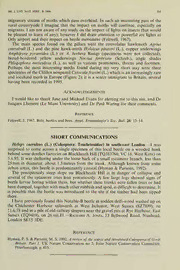
Helops caeruleus (L.) (Coleoptera: Tenebrionidae) in south-east London PDF
Preview Helops caeruleus (L.) (Coleoptera: Tenebrionidae) in south-east London
— BR.J.ENT.NAT.HIST..9: 1996 105 migratory stream ofmoths which pass overhead. In such an interesting part ofthe rural countryside I imagine that the impact on moths will continue, especially on migrants. I am not aware ofany study on the impact oflights on insects (but would be pleased to learn ofany); however I did draw attention to powerful arc lights at Orly airport and their impact on beetle movement (Feltwell, 1967). The main species found on the pillars were the convolulus hawkmoth Agrius convolvuli (L.) and the pine hawk-moth Hyloicus pinastri (L.), copper underwings Amphipyra pyramided (L.) or A. berbera Rungs (specimens were not collected), broad-bordered yellow underwings Noctua fimbriate (Schreb.), angle shades Phlogophora meticulosa (L.), as well as various prominents, thorns and footmen. Perhaps the most interesting moths found during my very short stay were three specimens oftheClifden nonpareil Catocalafraxini(L.) which is an increasinglyrare and localized moth in Europe (Figure 2); it is a scarce immigrant to Britain, several having been recorded in 1995. Acknowledgements I would like to thank Jane and Michael Evans for alerting me to this site, and Dr Jacques Lhonore (Le Mans University) and Dr Paul Waring for their comments. Reference Feltwell, J. 1967. Bats, beetles and bees. Amat. Entomologist's Soc. Bull. 26: 13-14. SHORT COMMUNICATIONS — Helops caeruleus (L.) (Coleoptera: Tenebrionidae) in south-east London. I was surprised to come across a single specimen of this local beetle on a wooded bank behind somederelict factorieson Blackheath Hill (TQ383766; VC 16,West Kent) on 3.x.95. It was sheltering under the loose bark ofa small sycamore branch, less than mm 25 in diameter, about 1.5metres from the trunk. Although known from some urban areas, this beetle is predominantly coastal (Hyman & Parsons, 1992). The precipitously steep slope on Blackheath Hill is in danger of collapse and several of the sycamore trees lean precariously. A few large logs showed signs of beetle larvae boring within them, but whether these trunks were fallen trees or had beendumped, togetherwithmuchotherrubbishandspoil, isdifficulttodetermine. It is possible that the beetle was introduced to the site if the timber had been tipped there. I have previously found this Notable-B beetle in sodden drift-wood washed up on the Chichester Harbour saltmarsh at West Itchenor, West Sussex (SZ7899), on 11.ii.78 and inapileofoldrailwaysleepersnearthegravel pitsat Rye Harbour, East Sussex (TQ9419), on 26.viii.81. Richard A. Jones, 13 Bellwood Road, Nunhead, London SE15 3DE. Reference Hyman, P. S. & Parsons, M. S. 1992. A reviewofthescarceandthreatenedColeopteraofGreat Britain. Part 1. UK Nature Conservation no 3. Joint Nature Conservation Committee, Peterborough, p.415.
